turn signal CADILLAC CTS 2007 1.G Owner's Manual
[x] Cancel search | Manufacturer: CADILLAC, Model Year: 2007, Model line: CTS, Model: CADILLAC CTS 2007 1.GPages: 518, PDF Size: 2.77 MB
Page 268 of 518
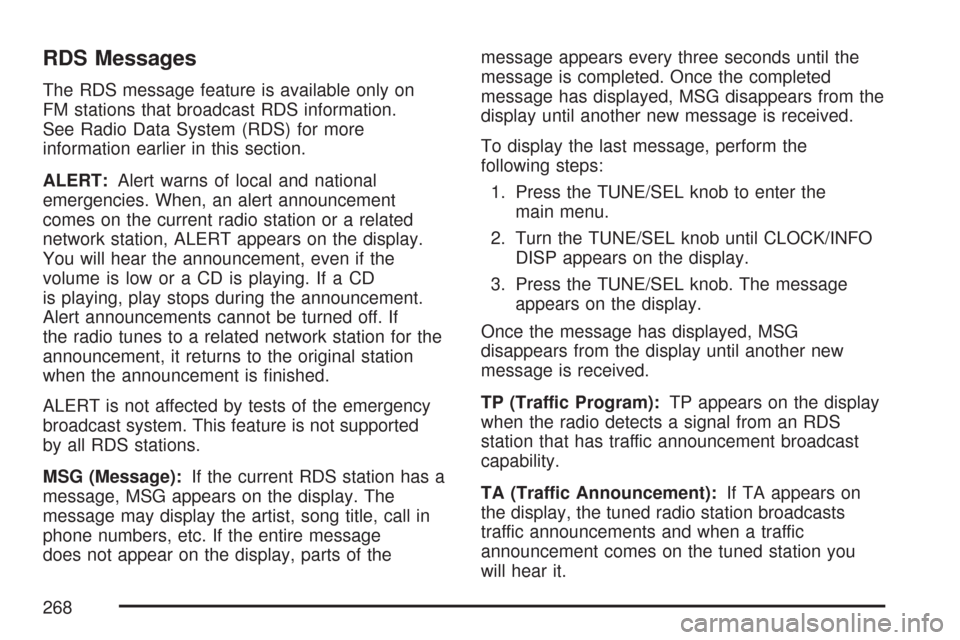
RDS Messages
The RDS message feature is available only on
FM stations that broadcast RDS information.
See Radio Data System (RDS) for more
information earlier in this section.
ALERT:Alert warns of local and national
emergencies. When, an alert announcement
comes on the current radio station or a related
network station, ALERT appears on the display.
You will hear the announcement, even if the
volume is low or a CD is playing. If a CD
is playing, play stops during the announcement.
Alert announcements cannot be turned off. If
the radio tunes to a related network station for the
announcement, it returns to the original station
when the announcement is �nished.
ALERT is not affected by tests of the emergency
broadcast system. This feature is not supported
by all RDS stations.
MSG (Message):If the current RDS station has a
message, MSG appears on the display. The
message may display the artist, song title, call in
phone numbers, etc. If the entire message
does not appear on the display, parts of themessage appears every three seconds until the
message is completed. Once the completed
message has displayed, MSG disappears from the
display until another new message is received.
To display the last message, perform the
following steps:
1. Press the TUNE/SEL knob to enter the
main menu.
2. Turn the TUNE/SEL knob until CLOCK/INFO
DISP appears on the display.
3. Press the TUNE/SEL knob. The message
appears on the display.
Once the message has displayed, MSG
disappears from the display until another new
message is received.
TP (Traffic Program):TP appears on the display
when the radio detects a signal from an RDS
station that has traffic announcement broadcast
capability.
TA (Traffic Announcement):If TA appears on
the display, the tuned radio station broadcasts
traffic announcements and when a traffic
announcement comes on the tuned station you
will hear it.
268
Page 277 of 518
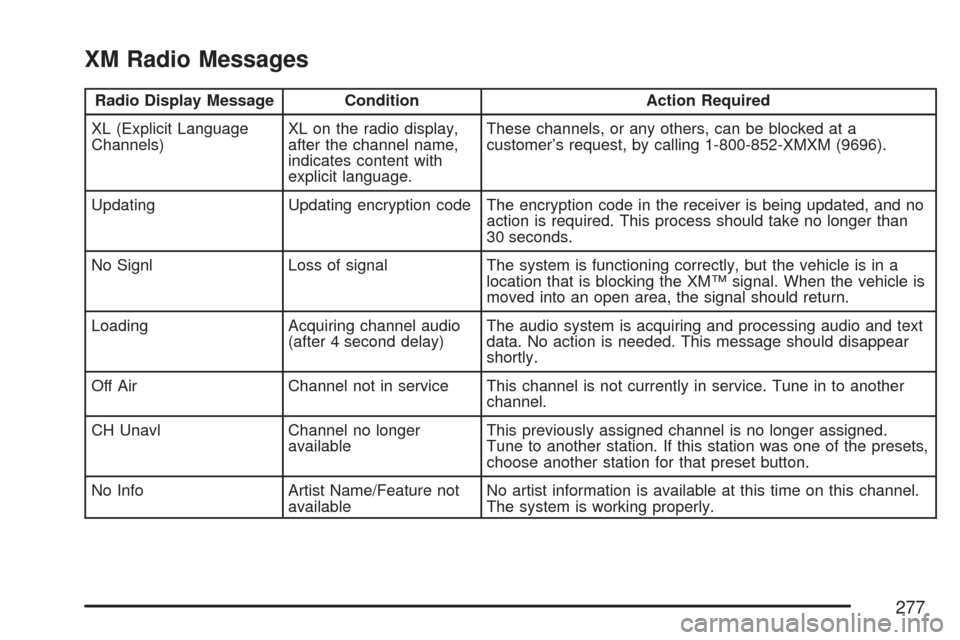
XM Radio Messages
Radio Display Message Condition Action Required
XL (Explicit Language
Channels)XL on the radio display,
after the channel name,
indicates content with
explicit language.These channels, or any others, can be blocked at a
customer’s request, by calling 1-800-852-XMXM (9696).
Updating Updating encryption code The encryption code in the receiver is being updated, and no
action is required. This process should take no longer than
30 seconds.
No Signl Loss of signal The system is functioning correctly, but the vehicle is in a
location that is blocking the XM™ signal. When the vehicle is
moved into an open area, the signal should return.
Loading Acquiring channel audio
(after 4 second delay)The audio system is acquiring and processing audio and text
data. No action is needed. This message should disappear
shortly.
Off Air Channel not in service This channel is not currently in service. Tune in to another
channel.
CH Unavl Channel no longer
availableThis previously assigned channel is no longer assigned.
Tune to another station. If this station was one of the presets,
choose another station for that preset button.
No Info Artist Name/Feature not
availableNo artist information is available at this time on this channel.
The system is working properly.
277
Page 303 of 518
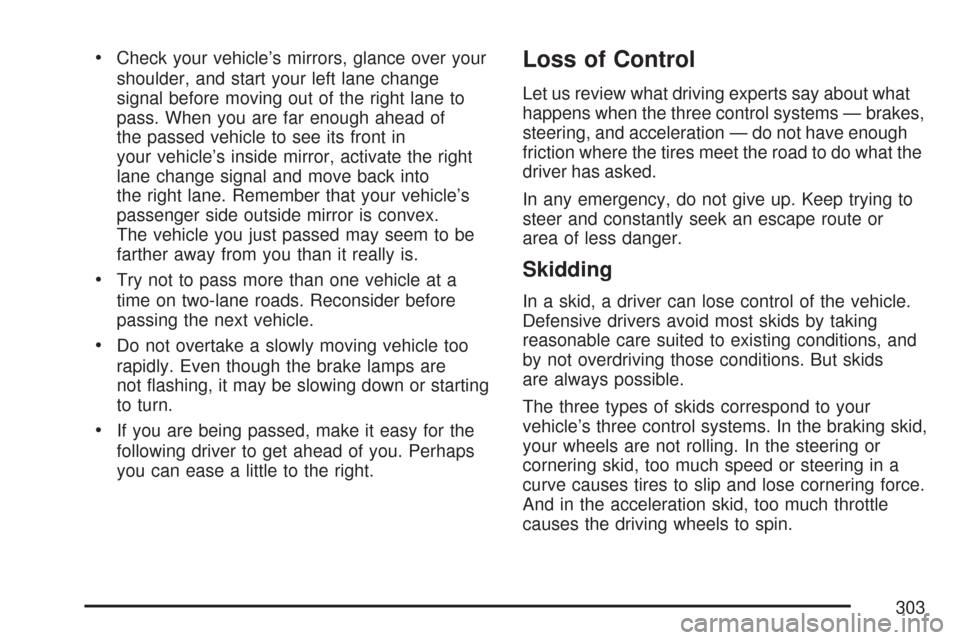
Check your vehicle’s mirrors, glance over your
shoulder, and start your left lane change
signal before moving out of the right lane to
pass. When you are far enough ahead of
the passed vehicle to see its front in
your vehicle’s inside mirror, activate the right
lane change signal and move back into
the right lane. Remember that your vehicle’s
passenger side outside mirror is convex.
The vehicle you just passed may seem to be
farther away from you than it really is.
Try not to pass more than one vehicle at a
time on two-lane roads. Reconsider before
passing the next vehicle.
Do not overtake a slowly moving vehicle too
rapidly. Even though the brake lamps are
not �ashing, it may be slowing down or starting
to turn.
If you are being passed, make it easy for the
following driver to get ahead of you. Perhaps
you can ease a little to the right.
Loss of Control
Let us review what driving experts say about what
happens when the three control systems — brakes,
steering, and acceleration — do not have enough
friction where the tires meet the road to do what the
driver has asked.
In any emergency, do not give up. Keep trying to
steer and constantly seek an escape route or
area of less danger.
Skidding
In a skid, a driver can lose control of the vehicle.
Defensive drivers avoid most skids by taking
reasonable care suited to existing conditions, and
by not overdriving those conditions. But skids
are always possible.
The three types of skids correspond to your
vehicle’s three control systems. In the braking skid,
your wheels are not rolling. In the steering or
cornering skid, too much speed or steering in a
curve causes tires to slip and lose cornering force.
And in the acceleration skid, too much throttle
causes the driving wheels to spin.
303
Page 310 of 518

City Driving
One of the biggest problems with city streets is
the amount of traffic on them. You will want
to watch out for what the other drivers are doing
and pay attention to traffic signals.Here are ways to increase your safety in city
driving:
Know the best way to get to where you are
going. Get a city map and plan your trip
into an unknown part of the city just as you
would for a cross-country trip.
Try to use the freeways that rim and crisscross
most large cities. You will save time and
energy. SeeFreeway Driving on page 311.
Treat a green light as a warning signal.
A traffic light is there because the corner is
busy enough to need it. When a light
turns green, and just before you start to move,
check both ways for vehicles that have not
cleared the intersection or may be running the
red light.
310
Page 311 of 518
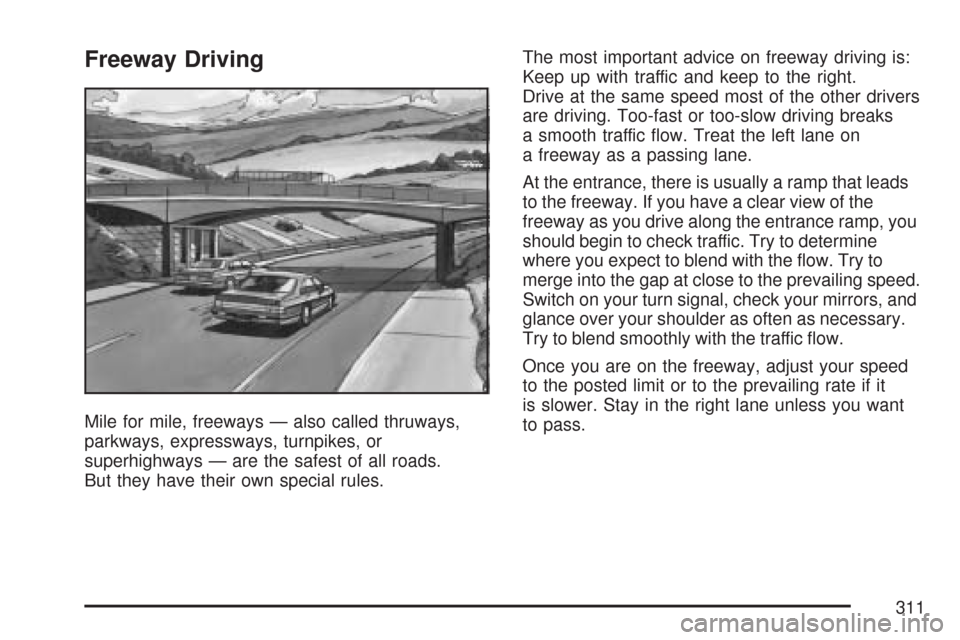
Freeway Driving
Mile for mile, freeways — also called thruways,
parkways, expressways, turnpikes, or
superhighways — are the safest of all roads.
But they have their own special rules.The most important advice on freeway driving is:
Keep up with traffic and keep to the right.
Drive at the same speed most of the other drivers
are driving. Too-fast or too-slow driving breaks
a smooth traffic �ow. Treat the left lane on
a freeway as a passing lane.
At the entrance, there is usually a ramp that leads
to the freeway. If you have a clear view of the
freeway as you drive along the entrance ramp, you
should begin to check traffic. Try to determine
where you expect to blend with the �ow. Try to
merge into the gap at close to the prevailing speed.
Switch on your turn signal, check your mirrors, and
glance over your shoulder as often as necessary.
Try to blend smoothly with the traffic �ow.
Once you are on the freeway, adjust your speed
to the posted limit or to the prevailing rate if it
is slower. Stay in the right lane unless you want
to pass.
311
Page 312 of 518

Before changing lanes, check your mirrors.
Then use your turn signal.
Just before you leave the lane, glance quickly
over your shoulder to make sure there is not
another vehicle in your blind spot.
Once you are moving on the freeway, make
certain you allow a reasonable following distance.
Expect to move slightly slower at night.
When you want to leave the freeway, move to the
proper lane well in advance. If you miss your
exit, do not, under any circumstances, stop and
back up. Drive on to the next exit.
The exit ramp can be curved, sometimes quite
sharply. The exit speed is usually posted. Reduce
your speed according to your speedometer, not
to your sense of motion. After driving for any
distance at higher speeds, you may tend to think
you are going slower than you actually are.Before Leaving on a Long Trip
Make sure you are ready. Try to be well rested.
If you must start when you are not fresh — such as
after a day’s work — do not plan to make too
many miles that �rst part of the journey. Wear
comfortable clothing and shoes you can easily
drive in.
Is your vehicle ready for a long trip? If you keep it
serviced and maintained, it is ready to go. If it
needs service, have it done before starting out.
Of course, you will �nd experienced and able
service experts in GM dealerships all across
North America. They will be ready and willing to
help if you need it.
Here are some things you can check before a trip:
Windshield Washer Fluid:Is the reservoir
full? Are all windows clean inside and outside?
Wiper Blades:Are they in good shape?
Fuel, Engine Oil, Other Fluids:Have you
checked all levels?
Lamps:Are they all working? Are the lenses
clean?
312
Page 329 of 518

Service........................................................ 332
Accessories and Modi�cations................... 332
California Proposition 65 Warning.............. 333
Doing Your Own Service Work.................. 333
Adding Equipment to the Outside of
Your Vehicle.......................................... 334
Fuel............................................................. 334
Gasoline Octane........................................ 334
Gasoline Speci�cations.............................. 335
California Fuel........................................... 335
Additives................................................... 336
Fuels in Foreign Countries........................ 336
Filling the Tank......................................... 337
Filling a Portable Fuel Container............... 339
Checking Things Under the Hood.............. 340
Hood Release........................................... 341
Engine Compartment Overview.................. 342
Engine Oil................................................. 346
Engine Oil Life System.............................. 349
Engine Air Cleaner/Filter............................ 351
Automatic Transmission Fluid.................... 353
Manual Transmission Fluid........................ 354Hydraulic Clutch........................................ 356
Engine Coolant.......................................... 356
Coolant Surge Tank Pressure Cap............ 360
Engine Overheating................................... 360
Overheated Engine Protection
Operating Mode..................................... 362
Cooling System......................................... 363
Power Steering Fluid................................. 368
Windshield Washer Fluid........................... 369
Brakes...................................................... 371
Battery...................................................... 375
Jump Starting............................................ 376
Rear Axle.................................................... 382
Headlamp Aiming........................................ 383
Bulb Replacement....................................... 386
High Intensity Discharge (HID) Lighting..... 386
Halogen Bulbs........................................... 386
Front Turn Signal and Fog Lamps............. 387
Taillamps, Turn Signal, Stoplamps and
Sidemarker Lamps................................. 388
Back-Up and License Plate Lamps............ 389
Replacement Bulbs................................... 389
Section 5 Service and Appearance Care
329
Page 387 of 518
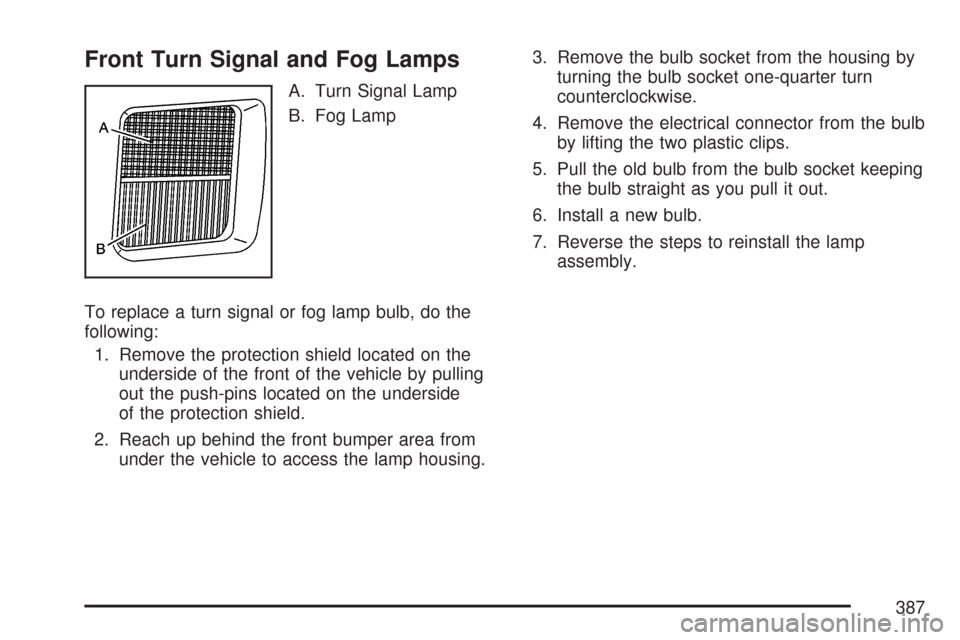
Front Turn Signal and Fog Lamps
A. Turn Signal Lamp
B. Fog Lamp
To replace a turn signal or fog lamp bulb, do the
following:
1. Remove the protection shield located on the
underside of the front of the vehicle by pulling
out the push-pins located on the underside
of the protection shield.
2. Reach up behind the front bumper area from
under the vehicle to access the lamp housing.3. Remove the bulb socket from the housing by
turning the bulb socket one-quarter turn
counterclockwise.
4. Remove the electrical connector from the bulb
by lifting the two plastic clips.
5. Pull the old bulb from the bulb socket keeping
the bulb straight as you pull it out.
6. Install a new bulb.
7. Reverse the steps to reinstall the lamp
assembly.
387
Page 388 of 518
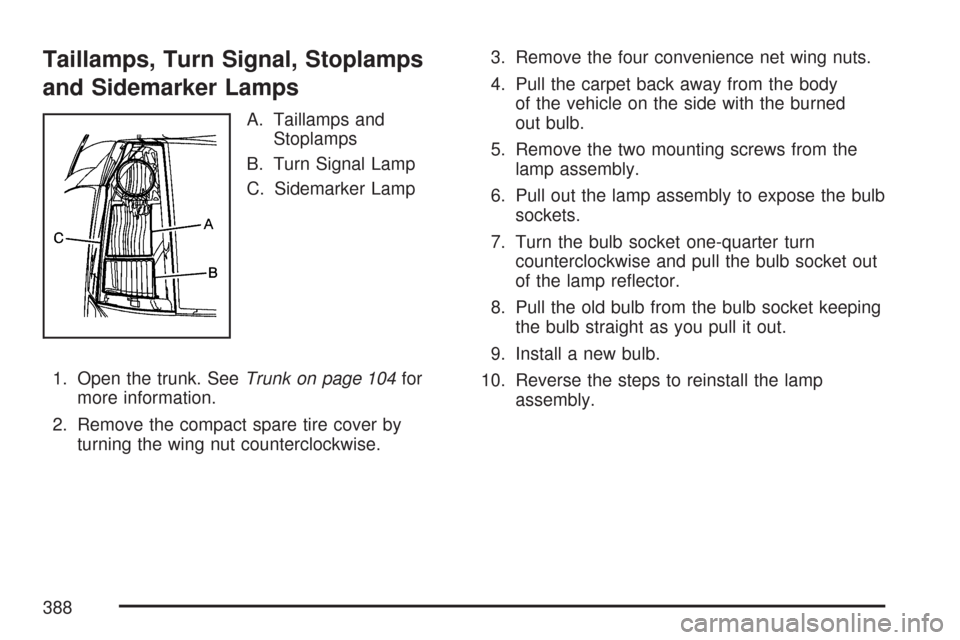
Taillamps, Turn Signal, Stoplamps
and Sidemarker Lamps
A. Taillamps and
Stoplamps
B. Turn Signal Lamp
C. Sidemarker Lamp
1. Open the trunk. SeeTrunk on page 104for
more information.
2. Remove the compact spare tire cover by
turning the wing nut counterclockwise.3. Remove the four convenience net wing nuts.
4. Pull the carpet back away from the body
of the vehicle on the side with the burned
out bulb.
5. Remove the two mounting screws from the
lamp assembly.
6. Pull out the lamp assembly to expose the bulb
sockets.
7. Turn the bulb socket one-quarter turn
counterclockwise and pull the bulb socket out
of the lamp re�ector.
8. Pull the old bulb from the bulb socket keeping
the bulb straight as you pull it out.
9. Install a new bulb.
10. Reverse the steps to reinstall the lamp
assembly.
388
Page 389 of 518
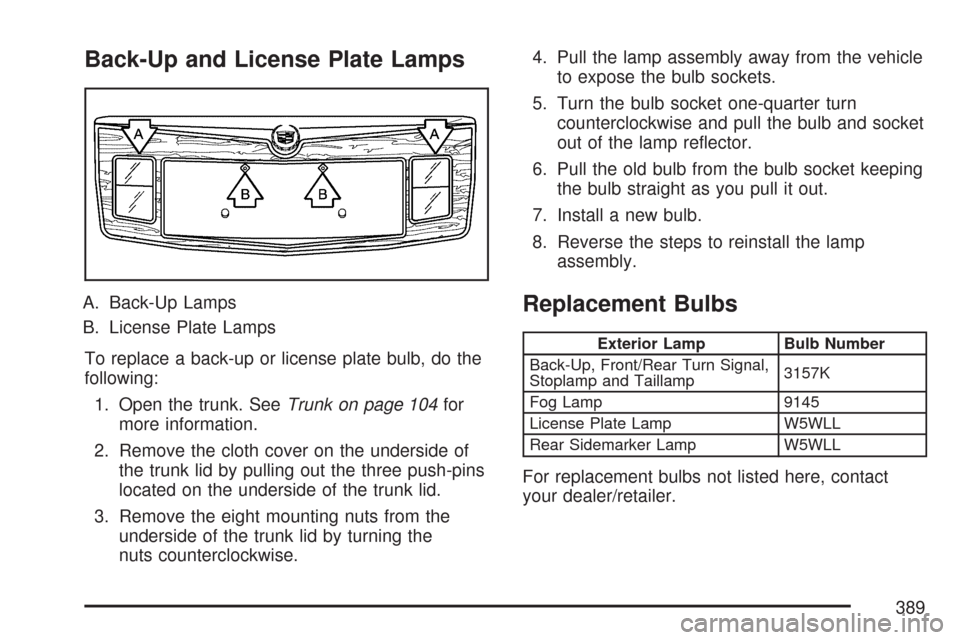
Back-Up and License Plate Lamps
A. Back-Up Lamps
B. License Plate Lamps
To replace a back-up or license plate bulb, do the
following:
1. Open the trunk. SeeTrunk on page 104for
more information.
2. Remove the cloth cover on the underside of
the trunk lid by pulling out the three push-pins
located on the underside of the trunk lid.
3. Remove the eight mounting nuts from the
underside of the trunk lid by turning the
nuts counterclockwise.4. Pull the lamp assembly away from the vehicle
to expose the bulb sockets.
5. Turn the bulb socket one-quarter turn
counterclockwise and pull the bulb and socket
out of the lamp re�ector.
6. Pull the old bulb from the bulb socket keeping
the bulb straight as you pull it out.
7. Install a new bulb.
8. Reverse the steps to reinstall the lamp
assembly.Replacement Bulbs
Exterior Lamp Bulb Number
Back-Up, Front/Rear Turn Signal,
Stoplamp and Taillamp3157K
Fog Lamp 9145
License Plate Lamp W5WLL
Rear Sidemarker Lamp W5WLL
For replacement bulbs not listed here, contact
your dealer/retailer.
389